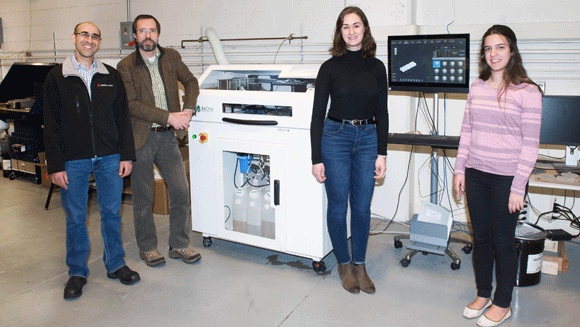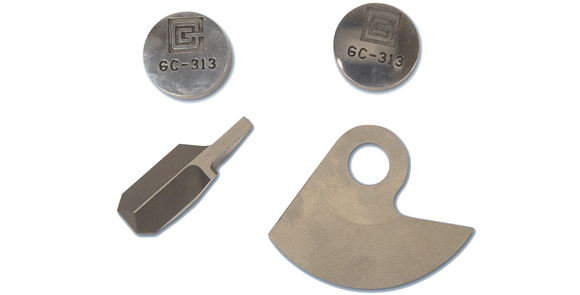University of Pittsburgh and General Carbide partner to improve tungsten carbide parts using Additive Manufacturing
January 14, 2019

From left: Drew Elhassid, Markus Chmielus, Katerina Kimes, and Pierangeli Rodriguez De Vecchis in the Swanson School’s Ansys Additive Manufacturing Laboratory (Courtesy University of Pittsburgh)
The University of Pittsburgh and General Carbide Corporation in Greensburg, Pennsylvania, USA, have partnered to explore the use of Additive Manufacturing in the production of tungsten carbide components. Tungsten carbide is seen as one of the most versatile metal compounds and is highly valued for its durability and strength, making it perfect for cutting tools, boring machines, and surgical instruments. However, when additively manufactured, tungsten carbide is susceptible to fractures and breakage when exposed to the extreme laser melting process used in the process.
The recent award to the University of Pittsburgh and General Carbide Corporation will enable research into improved base powders and Additive Manufacturing methods for more effective and economical use of tungsten carbide. The project was financed in part by a $57,529 grant from the Commonwealth of Pennsylvania’s Department of Community and Economic Development (DCED) and the first round of the PA Manufacturing Innovation Program (PAMIP). Cost share from Pitt’s Swanson School of Engineering and General Carbide will provide a total funding of $145,000.
Principal investigator is Markus Chmielus, Assistant Professor, and the student fellows are from the Department of Mechanical Engineering and Materials Science. The award will also fund two materials science and engineering students Katerina Kimes (Graduate) and Pierangeli Rodriguez De Vecchis (Undergraduate) as fellows in fundamental and applied research.
“Additive Manufacturing is increasingly adopted by industry to build highly complex metal parts, but the rapid local heating and cooling during energy beam-based 3D metal printing produces large thermal gradients which causes tungsten carbide to crack,” Dr Chmielus stated. “Binder Jet 3D printing is more effective because it selectively joins powder particles with a binder, one microscopic layer on top of another and without any temperature fluctuations during printing.”

Carbide part samples (Courtesy General Carbide Corporation)
Still key to utilising tungsten carbide, however, is that after a part is printed, it needs to withstand a sintering and potentially hipping procedure to densify and harden it for use. To achieve this, Dr Chmielus and General Carbide will investigate various tungsten carbide base powders that can be utilised in a Binder Jet AM system, as well as optimise the printing process and subsequent sintering and hipping.
“This research will enable General Carbide to expand our portfolio with more complex and versatile parts at a lower cost by partnering with the Swanson School and leveraging its expertise in Binder Jet 3D printing and Additive Manufacturing process optimisation,” noted Drew Elhassid, Chief Metallurgist and Manager of Lab, Pressing and Powder Production at General Carbide. “Additive Manufacturing is especially useful when needed to create the most demanding but low-count parts that we wouldn’t necessarily build on a consistent basis.”
“With the Manufacturing Innovation Program, the Wolf Administration aims to connect our best and brightest students with manufacturers to drive new technology and innovation in the manufacturing sector,” said Sheri Collins, deputy secretary for technology and innovation at the Pennsylvania Department of Community and Economic Development. “As manufacturing processes become more and more complex, these projects will keep Pennsylvania at the forefront of manufacturing innovation.”
















